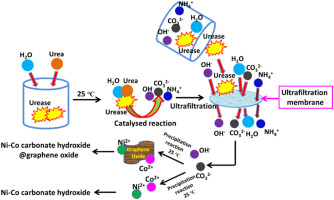Nano Energy ( IF 16.8 ) Pub Date : 2018-10-09 , DOI: 10.1016/j.nanoen.2018.09.069 Zheyin Yu , Yuanzhen Chen , Zhenxiang Cheng , George Tsekouras , Xiaoning Li , Xiaolin Wang , Xiangyang Kong , Shi Xue Dou

|
For the first time, a generalised enzyme-catalysed room temperature and atmospheric pressure method for synthesising metal carbonate hydroxides is shown. The enzyme urease was used to catalyse the hydrolysis of urea at room temperature and atmospheric pressure. Product CO32- and OH- anions were separated from urease and used to precipitate low crystallinity metal carbonate hydroxides from solutions containing Ni2+, Co2+, Zn2+ and/or Cu2+ cations. Ni-Co carbonate hydroxides with different Ni2+/Co2+ molar ratios were evaluated as supercapacitor electrodes. An optimised Ni2+/Co2+ molar ratio of 3:1 yielded a specific capacitance of 1499 F g-1 @ 1 A g-1 current density. Combining this material with graphene oxide increased the specific capacitance to 1656 F g-1 @ 1 A g-1 current density. In turn, using this composite as the positive electrode in an asymmetric supercapacitor with activated carbon as the negative electrode yielded a high energy density of 45.8 Wh kg-1 at a power density of 899 W kg-1, and 70% capacitance retention after 10,000 cycles. Our enzyme-catalysed room temperature and atmospheric pressure method may be promising for industrial-scale production of nano-materials for energy conversion and storage.
中文翻译:

酶催化的常温常压合成金属碳酸盐氢氧化物的储能
首次显示了用于合成金属碳酸盐氢氧化物的通用酶催化的室温和大气压方法。脲酶在室温和大气压下被用来催化尿素的水解。产物CO 3 2-和OH -的阴离子,从尿素酶分离,并用于沉淀低结晶金属碳酸盐氢氧化物从含有Ni溶液2+,钴2+,锌2+和/或Cu 2+阳离子。将具有不同Ni 2+ / Co 2+摩尔比的Ni-Co碳酸盐氢氧化物评估为超级电容器电极。优化的Ni 2+ / Co 2+摩尔比为3:1时,在1 A g -1电流密度下的比电容为1499 F g -1。将该材料与氧化石墨烯结合使用,在1 A g -1电流密度下将比电容提高到1656 F g -1。反过来,在不对称超级电容器中使用这种复合材料作为正极,活性炭作为负极,在功率密度为899 W kg -1时产生了45.8 Wh kg -1的高能量密度,并且在10,000次充电后保持了70%的电容周期。我们的酶催化的室温和大气压方法对于工业规模生产用于能量转换和存储的纳米材料可能很有希望。











































 京公网安备 11010802027423号
京公网安备 11010802027423号